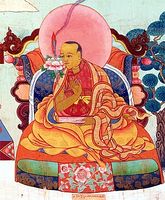Rngog blo ldan shes rab: Difference between revisions
No edit summary |
No edit summary |
||
| Line 22: | Line 22: | ||
|ReligiousAffiliation=Kadam | |ReligiousAffiliation=Kadam | ||
|PersonalAffiliation=rngog lo tsA ba legs pa'i shes rab | |PersonalAffiliation=rngog lo tsA ba legs pa'i shes rab | ||
|StudentOf=Rin chen bzang po | |StudentOf=Rin chen bzang po; Sajjana; Parahitabhadra | ||
|TeacherOf=shes rab 'bar; gro lung pa blo gros 'byung gnas; Zhang tshe spong chos kyi bla ma; rin chen nam mkha' rdo rje; rin chen grags | |TeacherOf=shes rab 'bar; gro lung pa blo gros 'byung gnas; Zhang tshe spong chos kyi bla ma; rin chen nam mkha' rdo rje; rin chen grags | ||
|BdrcLink=https://www.tbrc.org/#!rid=P2551 | |BdrcLink=https://www.tbrc.org/#!rid=P2551 | ||
Revision as of 10:01, 23 July 2018
| PersonType | Category:Lotsawas Category:Classical Tibetan Authors Category:Authors of Tibetan Works |
|---|---|
| MainNamePhon | Ngok Lotsāwa Loden Sherab |
| MainNameTib | རྔོག་བློ་ལྡན་ཤེས་རབ་ |
| MainNameWylie | rngog blo ldan shes rab |
| AltNamesTib | རྔོག་ལོ་ཙཱ་བ་ · ལོ་ཆེན་བློ་ལྡན་ཤེས་རབ་ |
| AltNamesWylie | rngog lo tsA ba · lo chen blo ldan shes rab · blo ldan shes rab |
| AltNamesOther | Ngok Lotsāwa · Ngok Loden Sherab · Lochen Loden Sherab · Loden Sherab |
| YearBirth | 1059 |
| YearDeath | 1109 |
| BornIn | yar 'brog (lho ka) |
| TibDateGender | Female |
| TibDateElement | Earth |
| TibDateAnimal | Pig |
| TibDateRabjung | 1 |
| ReligiousAffiliation | Kadam |
| PersonalAffiliation | rngog lo tsA ba legs pa'i shes rab |
| StudentOf | Rin chen bzang po · Sajjana · Parahitabhadra |
| TeacherOf | shes rab 'bar · gro lung pa blo gros 'byung gnas · Zhang Tsepong Chökyi Lama · rin chen nam mkha' rdo rje · rin chen grags |
| BDRC | https://www.tbrc.org/#!rid=P2551 |
| Treasury of Lives | https://treasuryoflives.org/biographies/view/Ngok-Loden-Sherab/4261 |
| IsInGyatsa | No |
| PosBuNayDefProv | Definitive |
| PosBuNayDefProvNotes |
|
| PosAllBuddha | Qualified Yes |
| PosAllBuddhaNote | "...both Ngok and Chapa argue that sentient beings do not have tathägata-essence on the basis of the first reason because they do not have the purified enlightened body of a buddha, rather they have thepotential to achieve an enlightened state. However, they agree that sentient beings have the tathägata-essence from the perspective of the second reason, which is that such-ness is indivisible or nondual. As Ngok states, 'That both a tathägata and ordinary beings have [tathägata] essence is actually the case.' The first reason is true only for enlightened beings, but only designated for ordinary beings; the second reason applies to both enlightened beings and sentient beings. Therefore, the two Kadam masters argue that sentient beings do not have the tathägata-essence from the perspective of either the first reason of the resultant essence or the third reason of the causal essence. Rather it is the second reason that becomes the central point for establishing the link between enlightenment and sentient beings. It is the middle reason that shows that sentient beings and tathâgatas are the same in their ultimate nature. In other words, the only thing that sentient beings have in common with enlightened beings is the ultimate nature of their minds." |
| PosAllBuddhaMoreNotes | Wangchuk, Tsering, The Uttaratantra in the Land of Snows, pp. 17-18 |
| PosWheelTurn | Third Turning |
| PosYogaMadhya | Madhyamaka |
| PosYogaMadhyaNotes | "rNgog considers the RGV to be a Madhamaka work, and hence its teaching to be definitive. His position is made clear in the introductory passage of the rGyud blam don bsdus, where RGV is identified as a treatise that explains sutras of definitive meaning (nitartha), whereas the other four treatises of Maitreya (i.e., Abhisamayalamkara, Mahayanasutralamkara, Madhyantavibhaga, and Dharmadharmatavibhaga) are listed as treatises that explain sutras of provisional meaning (neyartha)." Kano. K., Buddha-Nature and Emptiness, p. 249. |
| PosAnalyticMedit | Analytic Tradition |
| PosAnalyticMeditNotes | "These two traditions of rngog and btsan were respectively called the "analytical tradition" (thos bsam gyi lugs) and "meditative tradtion" (sgom lugs)."Kano. K., Buddha-Nature and Emptiness, p. 242 |
| PosEmptyLumin | Tathagatagarbha as the Emptiness That is a Nonimplicative Negation |
| PosEmptyLuminNotes |
|
| PosSvataPrasa | Svātantrika (རང་རྒྱུད་) |
| PosSvataPrasaNotes |
|
| PosVajrapada | First four are causes of the later three; also, the three jewels are the results of the latter four (which are substantive causes and attendant conditions) Kano. K., Buddha-Nature and Emptiness, pp. 252- |
| Other wikis |
If the page does not yet exist on the remote wiki, you can paste the tag |
"Tathagatagarbha as the Emptiness That is a Nonimplicative Negation" is not in the list (Tathāgatagarbha as the Emptiness That is a Non-implicative Negation (without enlightened qualities), Tathāgatagarbha as the Emptiness That is an Implicative Negation (with enlightened qualities), Tathāgatagarbha as Mind's Luminous Nature, Tathāgatagarbha as the Unity of Emptiness and Luminosity, Tathāgatagarbha as a Causal Potential or Disposition (gotra), Tathāgatagarbha as the Resultant State of Buddhahood, Tathāgatagarbha as the Latent State of Buddhahood that is Obscured in Sentient Beings, There are several types of Tathāgatagarbha, Tathāgatagarbha was Taught Merely to Encourage Sentient Beings to Enter the Path) of allowed values for the "PosEmptyLumin" property.

